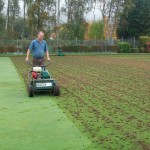When I set out to write my book, Performance Bowling Greens, it made me think about the main obstacles to success encountered by many of the bowling clubs I visit and in many ways it comes down to what can only be described as Common Sense versus Commerce. The 4 biggest obstacles I encounter again and again are as follows:
- Desperation Mode; or a state of mind that permeates a club when nothing they do seems to yield the results they crave.
- Lack of Consistency; which is direct result of the 1st obstacle, and is when the club repeatedly changes its approach to maintenance because it basically has no faith in any of the maintenance models it encounters.
- Tradition; although a lot of the traditions in question are not that old.
- Greenkeeping Myths.
The reasons for the problems I have just mentioned are mainly to do with the need that exists in every
industry to have companies or people who can supply materials and equipment in order for the work of that industry (in our case greenkeeping) to go ahead. So you see as greenkeepers or bowling clubs we are part of a commercial chain that needs constant lubrication in order to keep going. The end result of that process is the pressure put on all of us to try new things, new machines, new fertilisers, new chemicals etc. And of course this isn’t a bad thing in itself, because if it wasn’t for this continual process we wouldn’t have any of the tools we need to continue maintaining our green. The trouble comes when laymen or greenkeepers lacking confidence in their abilities are constantly bombarded with new “stuff” by “experts”. This leads to “new traditions” which lead to a lack of consistency, which leads to poor results, which leads to desperation for a solution and desperate people are willing to believe anything, so even myths can take on the appearance of common sense.
In Performance Bowling Greens I will be detailing a more measured and calm approach to bowling green maintenance based on scientific fact, a deep understanding of nature and the interaction between turfgrass and soil. An approach, in fact a full program you can follow to ensure that your green performs to a very high standard at a reasonable cost.
And its there that we will pick up the story tomorrow, as I will be looking at how heavily the future of bowling depends on the ability of clubs like yours to deliver consistent high performance on what can only be described as a shoestring budget.
You can get your copy of Performance Bowling Greens here. Meantime I’ll will be back tomorrow with more news.


